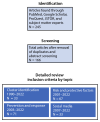Background and Rationale - CDC Guidance for Communities Assessing, Investigating, and Responding to Suicide Clusters, United States, 2024
- PMID: 38412112
- PMCID: PMC10899087
- DOI: 10.15585/mmwr.su7302a1
Background and Rationale - CDC Guidance for Communities Assessing, Investigating, and Responding to Suicide Clusters, United States, 2024
Abstract
To assist community leaders in public health, mental health, education, and other fields with developing a community response plan for suicide clusters or for situations that might develop into suicide clusters, in 1988, CDC published Recommendations for a Community Plan for the Prevention and Containment of Suicide Clusters (MMWR Suppl 1988;37[No. Suppl 6]:1-12). Since that time, the reporting and investigation of suicide cluster events has increased, and more is known about cluster risk factors, assessment, and identification. This supplement updates and expands CDC guidance for assessing, investigating, and responding to suicide clusters based on current science and public health practice. This report is the first of three in the MMWR supplement that describes an overview of suicide clusters, information about the other reports in this supplement, methods used to develop the supplement guidance, and the intended use of the supplement reports. The second report, CDC Guidance for Community Assessment and Investigation of Suspected Suicide Clusters - United States 2024, describes the potential methods, data sources and analysis that communities can use to identify and confirm suspected suicide clusters, and better understand the relevant issues. The final report, CDC Guidance for Community Response to Suicide Clusters - United States, 2024, describes how local public health and community leaders can develop a response plan for suicide clusters. The guidance in this supplement is intended as a conceptual framework that can be used by public health practitioners and state and local health departments to develop response plans for assessing and investigating suspected clusters that are tailored to the needs, resources, and cultural characteristics of their communities.
Conflict of interest statement
All authors have completed and submitted the International Committee of Medical Journal Editors form for disclosure of potential conflicts of interest. No potential conflicts of interest were disclosed.
Figures
Similar articles
-
CDC Guidance for Community Response to Suicide Clusters, United States, 2024.MMWR Suppl. 2024 Feb 29;73(2):17-26. doi: 10.15585/mmwr.su7302a3. MMWR Suppl. 2024. PMID: 38412137 Free PMC article.
-
CDC Guidance for Community Assessment and Investigation of Suspected Suicide Clusters, United States, 2024.MMWR Suppl. 2024 Feb 29;73(2):8-16. doi: 10.15585/mmwr.su7302a2. MMWR Suppl. 2024. PMID: 38412115 Free PMC article.
-
Investigating suspected cancer clusters and responding to community concerns: guidelines from CDC and the Council of State and Territorial Epidemiologists.MMWR Recomm Rep. 2013 Sep 27;62(RR-08):1-24. MMWR Recomm Rep. 2013. PMID: 24067663
-
An update on cancer cluster activities at the Centers for Disease Control and Prevention.Environ Health Perspect. 2007 Jan;115(1):165-71. doi: 10.1289/ehp.9021. Environ Health Perspect. 2007. PMID: 17366838 Free PMC article. Review.
-
Council of State and Territorial Epidemiologists/CDC Surveillance Case Definition for Multisystem Inflammatory Syndrome in Children Associated with SARS-CoV-2 Infection - United States.MMWR Recomm Rep. 2022 Dec 16;71(4):1-14. doi: 10.15585/mmwr.rr7104a1. MMWR Recomm Rep. 2022. PMID: 36520808 Free PMC article. Review.
Cited by
-
Impairment in personality functioning predicts young adult suicidal ideation and suicide attempt above and beyond depressive symptoms.Res Psychother. 2025 Feb 3;27(3):814. doi: 10.4081/ripppo.2024.814. Res Psychother. 2025. PMID: 39898757 Free PMC article.
-
Surveillance for Violent Deaths - National Violent Death Reporting System, 50 States, the District of Columbia, and Puerto Rico, 2022.MMWR Surveill Summ. 2025 Jun 12;74(5):1-42. doi: 10.15585/mmwr.ss7405a1. MMWR Surveill Summ. 2025. PMID: 40493548 Free PMC article.
-
CDC Guidance for Community Response to Suicide Clusters, United States, 2024.MMWR Suppl. 2024 Feb 29;73(2):17-26. doi: 10.15585/mmwr.su7302a3. MMWR Suppl. 2024. PMID: 38412137 Free PMC article.
-
Factors associated with multiple-death suicides among rural US decedents.J Rural Health. 2025 Jan;41(1):e70003. doi: 10.1111/jrh.70003. J Rural Health. 2025. PMID: 39962337 Free PMC article.
References
-
- CDC. CDC WONDER: About multiple cause of death, 2018–2021, single race. Atlanta, GA: US Department of Health and Human Services, CDC; 2023. https://wonder.cdc.gov/mcd-icd10-expanded.html
-
- CDC. CDC WONDER: About underlying cause of death, 1999–2020. Atlanta, GA: US Department of Health and Human Services, CDC; 2023. https://wonder.cdc.gov/ucd-icd10.html
-
- Substance Abuse and Mental Health Services Administration. Highlights for the 2021 National Survey on Drug Use and Health. Rockville, MD: US Department of Health and Human Services, Substance Abuse and Mental Health Services, Center for Behavioral Health Statistics and Quality; 2023. https://www.samhsa.gov/data/sites/default/files/2022-12/2021NSDUHFFRHigh...
-
- CDC. Youth Risk Behavior Survey: data summary & trends report 2011–2021. Atlanta, GA: US Department of Health and Human Services, CDC; 2023.. https://www.cdc.gov/healthyyouth/data/yrbs/pdf/YRBS_Data-Summary-Trends_...
MeSH terms
LinkOut - more resources
Full Text Sources
Medical

